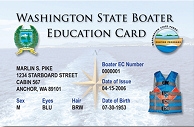Boating Basics
Know the Law
To ensure the safety of yourself and others, get to know Washington state’s boating laws.
Check out the Adventures in Boating Washington Handbook to learn many of Washington state’s boating laws, including the following:
- Proper fueling.
- How to secure a boat to a trailer.
- The right way to launch a boat into the water.
- Navigational rules.
- Steps for handling bad weather and boating emergencies.
Registering your Vessel
Register your boat with the Washington State Department of Licensing. To navigate, operate, employ, or moor your vessel in Washington, you must have a Washington title, registration card, and registration decals, except when your vessel is:
- a canoe, kayak, or not propelled by a motor or sail.
- less than sixteen feet in length and has a motor of ten horsepower or less and is used on non-federal waters only.
- properly registered by a resident of another state or country who uses Washington waters for sixty days or fewer.
See other exemptions.
The registration card (the cutout portion of the Vessel Registration Certificate) must be onboard whenever you use your vessel.
Operator Age and Boating Education Requirements
Counties and cities may have further restrictions so remember to check in with them before heading out on the water. Find your local boating laws.
- Anyone twelve years old and older may operate a motorboat of fifteen horsepower and greater with a Washington Boater Education Card.
- Without a card, the person must be supervised by someone at least sixteen years old, who is carrying a Boater Education Card.
- Anyone born before January 1, 1955 is exempt from needing to carry a Boater Education Card.
- Personal Watercraft – You must be at least fourteen years old to operate a personal watercraft. Remember, it is illegal to lease, hire, or rent a personal watercraft to anyone under sixteen years old.
Be Whale Wise
Vessel traffic is one of a number of things impacting the survival of southern resident killer whales, which are listed as endangered under the federal Endangered Species Act. Boaters can do their part to protect southern resident killer whales and keep themselves safe by following Be Whale Wise regulations, which include:
- As of January 1, 2025, boats must stay 1,000 yards from Southern Resident killer whales.
- Slowing down to seven knots within a half-mile of southern residents
- Watching for and using the Whale Warning Flag, which helps notify boaters of whales nearby. Slow down if you see the flag. To get a flag of your own, visit the San Juan Marine Resources Committee’s website.
- Turning off fish finders and/or depth sounders if you see southern residents in the distance.
- Helping promote safe waters for people and orcas. Report violations on the Be Whale Wise website.
Navigating on Washington Waters
Safe navigation is the responsibility of all boaters. Even though no vessel will have absolute right-of-way over other boats, here are three basic rules that every operator should know and follow:
- Practice good seamanship.
- Maintain a safe speed and distance.
- Keep a sharp lookout.
Remember, it’s illegal to obstruct navigation by doing any of the following:
- Anchoring in the traveled part of a river or channel so that other vessels are interfered with or prevented from passing through.
- Operating any vessel in a way that it will interfere with the safe navigation of other vessels.
- Mooring or attaching to a buoy (other than a mooring buoy), beacon, light, or any other navigational aid placed by authorities on public waters.
- Moving, displacing, tampering with, damaging, or destroying any navigational aid.
Prevent Pollution
Spilling oil or a hazardous substance into state waters is illegal. Polluters may be fined up to $10,000 for each violation or $100,000 for each day the oil poses a risk to the environment, or even more if the spill was intentional. Visit Clean, Green Boating at Washington Department of Ecology’s website to learn more.
Pump Out, Don’t Dump Out
Puget Sound is a No Discharge Zone. Sewage from vessels cannot go into the water.
Three ways to not discharge:
- Use a pumpout to empty your vessel sewage tank.
- Use dump stations to empty your portable toilet.
- Use an onshore restroom.
Don’t Transport Nuisance Species
Washington State law prohibits transport of any water-based, non-native plants and creatures on any boat, trailer, fishing gear, or bait well. If found, law enforcement may stop you and require you to clean your vessel or gear.
To learn more about these aquatic invasive species, how to spot them, and what to do if you find them, visit the Washington Department of Fish and Wildlife’s website.
Clean, Drain, Dry
If it’s been in the water, it could be contaminated by aquatic invasive species. Practicing Clean, Drain, Dry with all your gear, equipment, and watercraft is key to preventing accidental transportation of invasive species. Report sightings online at the Washington Invasive Species Council website.
- Clean: Remove all visible aquatic plants and animals from your boat, motor, trailer, and other equipment before leaving the access area.
- Drain: Always drain live wells and transom wells before leaving the water access area.
- Dry: Open and air or towel dry compartments on watercraft and gear.
